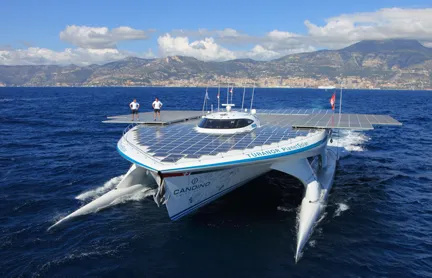
As the worlds largest solar-powered boat heads toward Miami for its U.S. debut and the start of a 16-city world tour, I was reminded of one of the most frequent questions I hear from Practical Sailor readers: “Which is best, solar panels or a wind generator?” The answer, like many things regarding cruising equipment, depends on where you cruise and the type of boat you own.
The MS Turanor PlanetSolar, the worlds largest solar-powered yacht ever constructed, offers a persuasive case for solar power. The sun-powered, 102-foot catamaran, which recently broke its existing Guinness World Record for completing the fastest trans-Atlantic crossing with a solar boat (22 days), docks in Miami later this week. Stops in New York and Boston are also included in its 2013 itinerary. Following its U.S. visit, the vessel will set sail on a trans-Atlantic, scientific expedition to study climate change.
For most U.S. sailors contemplating investing in renewable energy sources for the first time, it makes sense to buy a solar panel before a wind generator. For about $700, you can buy a pair of 60-watt panels that can generate about 240 watt-hours or 20 amp hours (assuming four hours of peak sunlight). This won’t cover the amp-hour requirements of a modern cruising boat, however. (To roughly convert a solar panel’s watt rating to amp-hours per day, marine technical author Nigel Calder offers the formula: amp-hours per day at 12 volts = the panel’s rated wattage 3.) Although wind generators can deliver more than double this output during a 24-hour period, many U.S. anchorages and marinas don’t have the consistently breezy conditions they require to reach their potential. That conclusion was borne out during our long-term test of five models on a hilltop in Rhode Island, a relatively windy U.S. location, during the mid-1990s. Testers then came to the dismaying conclusion that over the long haul, an average 50-watt solar panel would outperform the units we tested.
Results were different in 2007, when we simultaneously tested five wind generators through a breezy Chesapeake Bay winter. The results of that wind generator test (accessible only to subscribers) and an article on choosing a wind generator based on that test offer a more optimistic view of wind energy. As the results of the 2007 test demonstrate, in windy areas such as the Caribbean, wind generators can do a much better job of keeping up with the demands of 12-volt refrigeration, usually the biggest energy hog on a cruising boat.
Ultimately, which system will be most efficient for you depends greatly on the region you intend to cruise. Although many long-term cruisers making a loop through the Caribbean do just fine with solar alone, those with high energy demands find that supplementing solar with wind energy offers the best opportunity for keeping batteries charged 24/7.
There are several websites that discuss the pros and cons of these alternative energy sources from a sailors perspective. EMarine, a company that sells both solar panels and wind generators, offers a cut-and-dried comparison of solar vs. wind. Although the article is based on some generic assumptions that may or may not apply to your cruising region, it offers a concise look at the pros and cons. Nigel Calders “Boatowners Mechanical and Electrical Manual” offers a more detailed discussion of these two systems. Last year’s blog update on solar panels also includes a number of links to Practical Sailor articles on solar trickle chargers, using multi-point power technology to boost solar panel output, tips on prolonging lead-acid battery life, and options for mounting high-output installation.
If you can look past the obvious sales pitch, West Marines West Advisor on solar panels also offers a good overview of solar systems for marine use. Although it has been a while since we have looked at solar panels, we are not big fans of flexible panels. If you are seriously in the market for a solar panel, look for rigid panels with 20-plus-year warranties. Since much of the appeal of solar panels is their durability, we would be interested in hearing about readers experiences with specific brands of solar panels over the long haul in the comments section below.



































